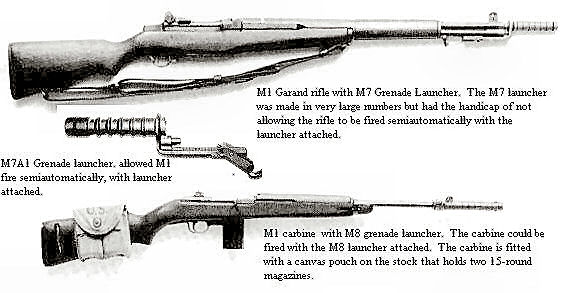The launcher, essentially an extension of the rifle, had six graduations for different ranges (for use in high-angle fire, as with signal and illumination rounds), and also a grenade retainer spring. In use, the launcher was inserted into the stabilizer assembly of the rifle grenade to the appropriate range graduation.
A special grenade cartridge, always hand-loaded, was the propellant for the grenade mounted on a rifle grenade launcher. The first widely used grenade launcher for the M1, the M7, attached to the bayonet lug by a hinged clamp, and had a stud that fitted into the gas cylinder valve screw to hold it open and vent the excess gas from firing this special cartridge. With the development of the M7A1, which permitted full semiautomatic fire when mounted, the M1 became very effective as a grenade launcher. Using the M3 grenade cartridge, an experienced rifleman could fire a MarkII fragmentation grenade with good accuracy almost 200 yards!
The M1 carbine's M8 grenade launcher used the M6 grenade launching cartridge. At about 65% the muzzle energy of the M1 rifle, the carbine could function in the fully semiautomatic mode with the launcher mounted. The M8 clamped on the end of the barrel and was held in place by a wing nut.
There were two basic categories of rifle grenades: hand grenades, projected from the launcher by means of an adapter, and grenades specially designed as rifle grenades. Chemical and pyrothechnic signal flares might be of either type, with star signal flares being designed for rifle launch.
Another example of dedicated rifle grenades was the M9/M9A1 HEAT anti-tank grenade. The M9 weighed about 1.3 pounds, contained a shaped charge similar to the bazooka AT rocket, could penetrate 3 to 4 inches of armor, and had a maximum effective range of 250 yards (probable effectiveness about 100 yards).
Gases produced when the hand-loaded grenade cartridge is fired launch the grenade. For most of the designed rifle grenades, however, the thrust was not great enough to lift them to the desired altitude or propel them with enough force. Therefore, a propelling charge, ignited by flame from the fired cartridge, was assembled in the base of some of the rifle grenades to provide the additional boost. At the same time, the flame from the propelling charge would ignite the black powder of any time train for a time delay fuze, if needed. Fuzes were standard in signal and illumination pyrotechnic rifle grenades.
Because of the heavy recoil generated by the grenade cartridge, the rifle (or carbine) was fired by firmly planting the butt on the ground, turned sideways to avoid damaging the stock.


